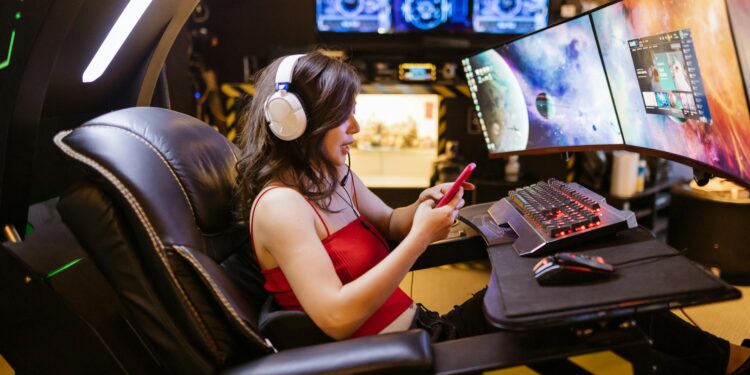The Rise of Real-Time Play: Why We Crave Live Digital Experiences

For decades, gaming has often been framed as a solitary pursuit. Think of the lone player immersed in a single-player campaign, headphones on, cut off from the outside world. Yet in 2025, the momentum has shifted. Group games, whether online board games, live table games, shooting games, or interactive sessions streamed through Twitch, are dominating digital culture.
This is not just about fun. It’s about connection. As digital life becomes increasingly synchronous, players are gravitating toward social gaming formats that recreate the immediacy of hanging out in person.
Instead of playing alone, gamers want to laugh, banter, and problem-solve together in real time. The rise of real-time play is redefining how we think about entertainment, identity, and community.
Why Group Games Now?
The preference for group games is partly cultural, partly technological. On the cultural side, after years of increased isolation (pandemic lockdowns, remote work, and screen-saturated routines) people are searching for synchronous, shared experiences. Video calls filled some of that void, but gaming has proven to be a more engaging way to connect.
On the technological side, faster internet speeds, Discord integration, and seamless cross-platform access have made real-time multiplayer experiences easier than ever. You don’t need expensive setups. Just a phone, a laptop, or a console and a few friends willing to join in, and you’re all set.
From Solitary Play to Collective Flow
Psychologists often talk about “flow,” the state of total immersion in an activity. Solitary games deliver this individually, but group games expand flow into a collective experience. When you and your friends are solving puzzles, dodging opponents in shooting games, or laughing over a virtual round of trivia, the joy multiplies.
This form of “co-presence” is different from being in the same physical room. It’s about being fully engaged with others in a shared digital space, something solitary campaigns or offline modes rarely replicate.
Twitch, Discord, and the New Gaming Town Square
Streaming platforms like Twitch have amplified the pull of real-time gaming. Watching a streamer isn’t just about passive viewing—it’s interactive. Audiences type comments, vote on decisions, and even join in on the play itself. This blend of entertainment and participation fuels the sense of belonging.
Meanwhile, Discord has become the digital campfire for group play. Entire communities form around specific online group games, from strategy titles to casual card platforms. Voice channels, live video sharing, and bots create a constant sense of “being there,” even if everyone is scattered around the globe.
The Appeal of Live Table Games
One of the fastest-growing niches in this space is live table games, where traditional formats like poker, blackjack, and roulette are streamed with live dealers. Unlike digital simulations, these adult experiences are deeply human-centred. Real-time interaction, video presence, and community chat create a hybrid between physical play and digital accessibility.
For many players, this scratches the itch of social interaction in a way that solitary card apps or offline casino simulators cannot. The appeal lies less in winning and more in the ritual of gathering, watching, and sharing reactions.
Shooting Games and Instant Adrenaline
Shooting games are another anchor of the real-time play movement. Unlike slower genres, shooters thrive on immediate coordination, quick reflexes, and teamwork. Titles like Valorant and Marvel Rivals allow squads of friends to strategise in real-time voice chat, foster camaraderie and even long-term bonds.
What was once labelled “competitive play” has now evolved into something more layered: the thrill of achievement mixed with the satisfaction of working toward goals together. In fact, research suggests that players of real-time group games report higher satisfaction levels than those who exclusively play solo campaigns.
Group Games as Digital Third Spaces
Urban sociologist Ray Oldenburg coined the term “third place” to describe public spaces like cafes or parks where community naturally flourishes. In the digital era, group games are becoming that third space.
Whether it’s a Discord game night, a Twitch watch-along, or friends exploring sandbox worlds, these activities replicate the casual togetherness of hanging out. The emphasis isn’t always on winning. Sometimes it’s about existing alongside each other. This is what some call “parallel play,” the art of simply being together while engaged in a shared but noncompetitive activity.
The Psychology of Real-Time Play
Why are people drawn to group games? The psychology is compelling:
- Social validation – Sharing wins and losses makes experiences feel more meaningful.
- Shared rituals – Weekly game nights or daily log-ins foster routine and belonging.
- Stress relief – Cooperative play reduces pressure compared to competitive solo runs.
- Identity expression – Gamers present avatars, voice, and humour as part of social identity.
Compared to solitary play, real-time interaction offers richer social rewards, often balancing out the cognitive and emotional investment.
Challenges and Critiques
Of course, the rise of real-time play isn’t without drawbacks. The very immediacy that makes group games appealing can also be demanding with constant notifications, fear of missing out, or even toxic group dynamics.
Some critics argue that the shift away from solitary immersion risks diluting deep storytelling experiences in gaming. Others worry that platforms prioritising synchronous interaction could encourage unhealthy screen time habits.
Yet these critiques are less about rejecting real-time play altogether and more about urging balance. Just as solitary play still has value, group experiences work best when integrated thoughtfully.
The Future: Social Gaming as Lifestyle
Looking ahead, the momentum behind real-time, synchronous gaming shows no signs of slowing. Expect to see:
- AI-driven matchmaking makes it easier to find communities that fit your vibe.
- Hybrid group games blending AR/VR with traditional formats for immersive meet-ups.
- Expanded cross-platform play, ensuring accessibility across PC, console, and mobile.
- Further integration of streaming, so gameplay and audience overlap seamlessly.
What’s clear is that group games are no longer just a category. They’re now a cultural mode of play. From Discord hangouts to interactive Twitch streams, they are becoming central to how we socialise, compete, and relax.








